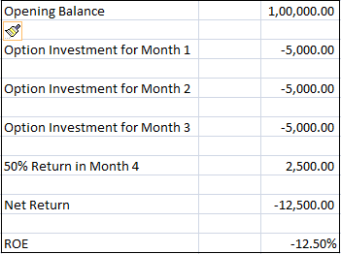Defining Risk in Options
Twitter is an interesting way to start conversations, unfortunately the limit of 144 chars means that one cannot explain the thoughts in detail and one can miss the nuances very easily. And the reason for this blog came about from this series of tweets
This is the series of tweet conversations that started with a little innocuous tweet by Deepak 🙂
https://twitter.com/deepakshenoy/status/423756691574779904
So, lets come back to the basic question – How does one define risk?
There are various way to define risk though one that I believe provides the correct meaning is “Risk is the permanent loss of capital, never a number” (Quote borrowed as often it is from the Internet) 😉
In the stock market, it does not matter what we buy, we risk the capital every time (even if there is supposed to be a huge margin of safety). But the problem comes in understanding the amount of risk when we trade options.
Lets assume you have 1 Lakh Rupees as Capital and want to take a trade where you are willing to risk 10K (10% of Capital). These are the ways you can take the trade. For sake of easy calculation, lets assume the price of stock at 100.
You can Buy 1000 Shares of the stock and have a stop at 90. A 10 Rupee move higher will give a return of 10% while one shall end up losing 10% of capital if stop loss gets triggered. A Risk to Reward ratio of 1:1
You can Buy a future (lets assume it has a quantity size of 1000). Now, though you are buying an equal quantity of shares, you are investing only the margin (lets assume the margin is 25%). Keeping another 25% aside for M2M would still leave us with 50% of the capital free.
The stock as usual moves to 110 and instead of a return of equity of 10%, you are actually getting a return of 20% since max capital allocated to it was 50% of the Lakh to start with. Using a small leverage of 1 times the capital, we have actually doubled the returns. Of course, the Risk:Reward remains the same since a 10K loss on 50K of deployed capital is 20% giving us the ratio of 1:1
Lets move to Options. Instead of buying a future, we can buy a option of say the 100 Call Option. The price of the option is based on a lot of factors not least of it would be the amount of time to expiry of the said option (others include how far away the option strike is from the stock price, the risk free rate of interest, the volatility of the stock being the other major factors)
Unlike the stock and futures, options do not have a Linear relationship which makes it harder for assumption of Profit and Loss. Lets assume the stock did nothing for 3 months after which the stock shot up by 10% one fine month. Return on Capital is still 10% for Cash Investment, 20% – Cost of Carry for futures. But the way to calculate would be much harder in case of options. Assuming each option costs 5%, we would have actually lost 15% of the capital before the month of the move. When the actual moves comes and if we still are holding with the same ATM strike (100 CE), we can get a return of approximately 50% on the investment amount. But before you get excited about 50%, here is some small calculation.
As you can see, even though one could get a 50% return on the investment in the option concerned, due to passage of time (& expiry of options in other months), you would have actually lost money trying to buy the same via options (and risking only 5% of the money every month). This despite one being right in terms of the actual move.
Of course, one could have minimized the risk by buying Deep in the Money options which would have had more of Intrinsic value and less of Time premium, but in this world of give and take, the lower amount of time premium comes with a higher amount of Risk on the capital itself.
Other than this, you can build various strategies where you can lower the risk by reducing the maximum reward. But even in the complex of strategies, they key requirement is the direction. Unless you have a strategy to deal with the direction, no amount of strategies can help and if you are sure of the direction, buying in Cash / Futures may be better than trying to leverage through options.




Recent Comments